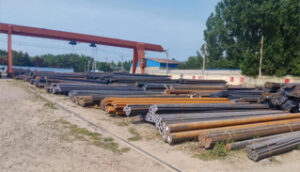Tool Steel for Woodworking Tools: Selection and Considerations
Introduction
From chisels and planes to saw blades and router bits, tool steel is an essential material for constructing high performance woodworking tools. The unique properties of tool steels enable the cutting edges, wear resistance, and strength required to efficiently shape and machine wood.
This article provides guidance on selecting appropriate tool steel grades for various woodworking applications based on the stresses, wear, and operating conditions encountered. Heat treating considerations specific to developing optimal woodworking tool properties are discussed. Recommendations are also provided for applying coatings or other enhancements to maximize performance.
Overview of Tool Steels for Woodworking
 Tool steels for woodworking tools include:
Tool steels for woodworking tools include:
- Carbon tool steels – Simple steels like W1/W2 providing a basic balance of hardness and toughness
- Shock resisting grades – Types like S7 with additional alloying to improve fracture resistance
- Cold work tool steels – Such as O1 or A2 offering increased hardness potential
- High speed steel – Providing the ultimate resistance to softening and wear but are more challenging to sharpen
By selecting the proper grade, tool steels can be tailored to meet the demands of various woodcutting, planing, turning, and other woodworking applications.
Key Properties Required in Woodworking Tool Steels
Critical performance needs include:
- Hardness – For sharp, durable cutting edges and resistance to abrasive wear
- Toughness – To absorb shock loads and prevent chipping or fracture
- Strength – To withstand bending or prying stresses without permanent deformation
- Wear Resistance – To maintain the cutting geometry in service against abrasive wood fibers
- Corrosion Resistance – For storage and environmental protection when not in use
- Ease of Sharpening – Allowing quick reconditioning of cutting edges as needed
The proper balance of these characteristics maximizes woodworking tool utility and longevity.
Tool Steel Selection Guidelines for Woodworking Tools
Recommended selections based on application:
Chisels and Hand Planes
- O1 or A2 cold work tool steel provides ideal combination of hardness, ease of sharpening, and toughness
Woodturning Tools
- HSS grades like M2 or M42 offer superior resistance to abrasive wear from wood fibers at higher cutting speeds
Saw Blades
- Carbon grades like W1 or W2 offer a good balance of hardness, toughness, and value
Router Bits
- Carbide tipped inserts brazed into steel shanks the best option for longevity
- HSS ideal for all-steel bits; coatings like TiN improve wear life
Block Planes
- Oil hardening shock resisting (ORSR) grades designed specifically for handling impact loads
Selecting tool steel matched to the particular woodworking function ensures optimal performance.
Heat Treating Considerations for Woodworking Tool Steels
Proper heat treatment development of woodworking tools necessitates:
- Austenitizing temperatures sufficiently high to dissolve complex carbides
- Rapid quenching in oil or air to transform to martensite; avoid cracking
- Tempering at lower temperatures of 300-400°F to maximize hardness
- Double or triple tempering to impart required toughness
- Sub-zero treatment can further enhance properties in some grades
- Stress relieving during machining to prevent distortion
The goal is to achieve the hardness necessary for sharp, durable edges along with sufficient fracture resistance under variable wood cutting loads.
Sharpening and Maintaining Woodworking Tool Steels
Effective sharpening and maintenance prolongs cutting performance:
- Use diamond stones or silicon carbide water stones to routinely sharpen edges
- Dress grinding wheels frequently to expose fresh abrasive grains
- Hone cutting edges with stropping compounds on leather for the ultimate sharpness
- Monitor edges for microchipping or wear indicating a need for regrinding
- Protect with rust inhibitors when storing to prevent discoloration or corrosion
- Periodic inspection for cracks or damage ensures sound condition
Proper and consistent sharpening routines maximize the working life of woodworking tool steels.
Surface Treatments to Improve Wood Tool Performance
Some surface enhancement options include:
Protective Coatings
- Titanium nitride (TiN) or other PVD coatings reduce friction and improve wear resistance
Anti-stick Coatings
- Prevent wood pitch, sap, or resins from adhering to cutting edges
Anti-corrosion Coatings
- Provide protection during storage; allow infrequent sharpening without degradation
Laser Engraving
- Provides visually distinctive marking while improving grip and retention in handles
Applying the appropriate coatings or treatments to high wear areas expands tool steel woodworking utility.
Innovations in Manufacturing Methods
 Emerging tool steel production methods offer new potential:
Emerging tool steel production methods offer new potential:
- Powder metallurgy – Allows very homogeneous fine grained microstructures for improved edge retention
- Metal injection molding – Permits complex shaped woodturning tools to be efficiently mass produced
- Additive manufacturing – Enables tailored cutting geometries to be 3D printed directly in tool steel
- Spray forming – Produces unique fine carbide distributions for enhanced wear resistance
Capitalizing on these advanced techniques can push woodworking tool performance to new levels.
Economic Considerations for Tool Steel Woodworking Tools
Important cost factors when selecting tool steel grades:
- Less expensive carbon and alloy grades often provide adequate performance at substantially lower cost than premium grades.
- Large volume commodity woodworking tools utilize lower cost oil hardening or carbon grades.
- More sophisticated woodworking tools justify use of premium HSS or PM grades for maximum working life.
- Carbide inserts brazed into steel bodies offer excellent durability at moderate cost.
- Appropriate sharpening routines further aid cost management.
Balancing tool steel performance against lifecycle cost and production volumes allows cost-effective woodworking tool designs.
Summary
The key takeaways regarding tool steels for woodworking are:
- Numerous tool steel grades are available to match performance needs of the application.
- Heat treating focuses on developing high hardness along with sufficient fracture toughness.
- Coatings and treatments combat wear, improve corrosion resistance, and prevent pitch or sap adhesion.
- Powder metallurgy and additive manufacturing provide means to further enhance properties and geometries.
- Cost considerations dictate use of value grades for high volume commodity wood tools.
With the proper selection and processing, tool steels continue providing the high performance cutting edges demanded by woodworkers.
Frequently Asked Questions
What are some differences in properties between tool steels for woodworking vs. metalworking?
Woodworking tool steels emphasize fracture toughness and ease of sharpening more than extreme wear resistance. Hardness levels around 60 HRC are typical for wood whereas metalworking applications often demand 65+ HRC.
Why are powder metallurgy tool steels not used more extensively for woodworking?
The higher cost of PM tool steels can’t always be justified for woodworking applications except for very high end custom tools. The more uniform carbide distributions offer only moderate benefits for cutting wood compared to metal alloys.
What heat treating differences are required for a large saw blade vs. a small chisel?
The higher section size of saw blades necessitates more complex stepped austenitizing and tempering cycles along with consideration of quenchant flow and agitation to avoid property variations from surface to core.
What are some coatings options used to improve performance of woodturning tools?
Titanium nitride and titanium carbonitride coatings deposited by PVD methods are excellent options for woodturning tools, providing lower friction, better heat resistance, and enhanced wear life.
Why has high speed steel not fully replaced carbon tool steels for saw blades?
The combination of additional cost along with sharpening and set-resetting challenges for HSS has limited its adoption, especially in cost-driven construction applications. However, HSS provides better wear life in industrial woodshops.
Please let me know if you have any other questions!

